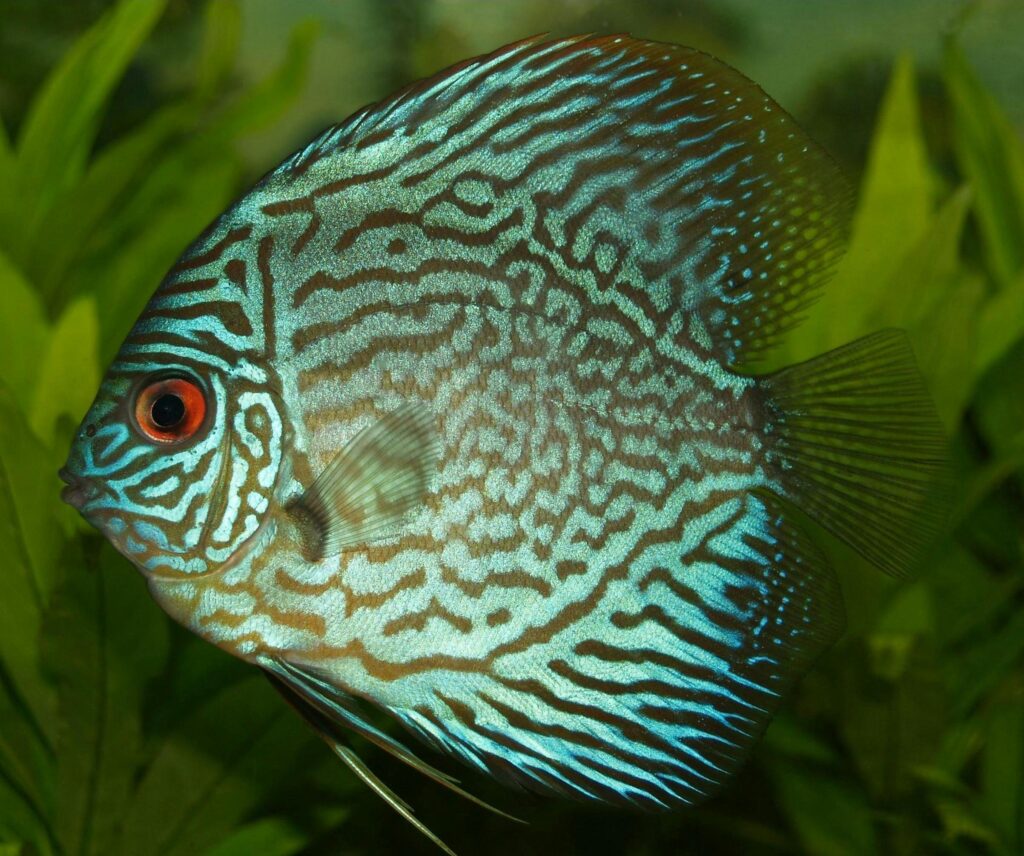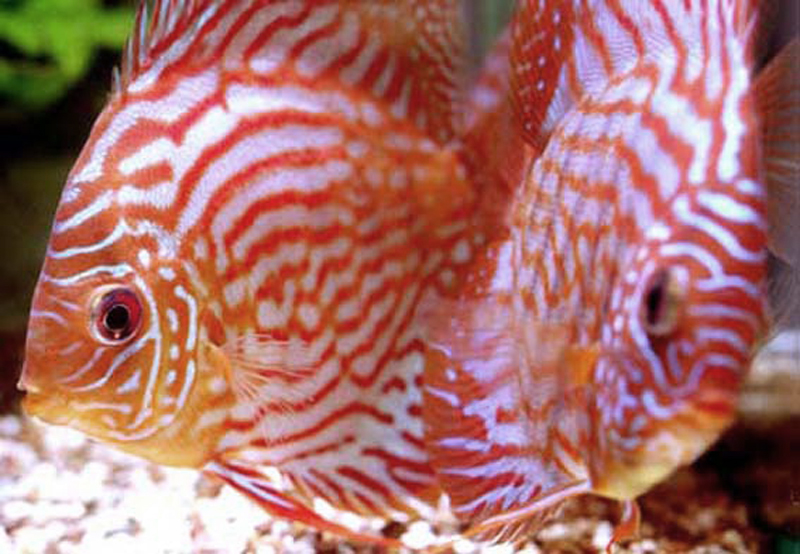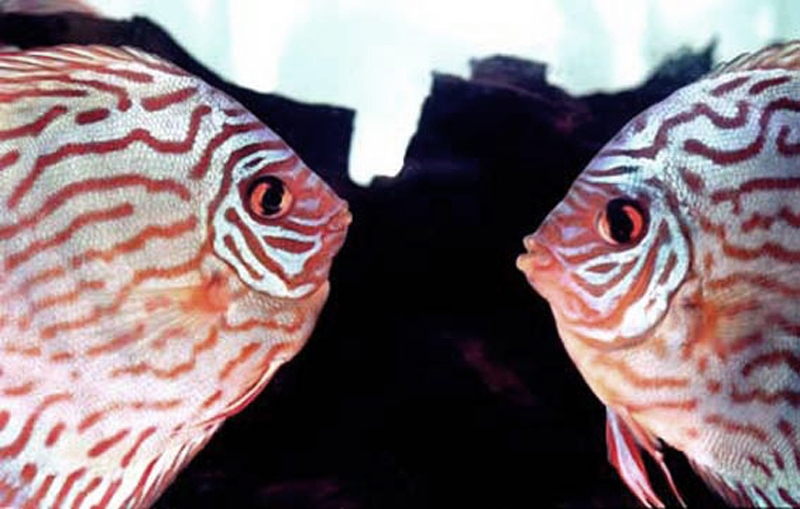Few fish inspire as much admiration—and trepidation—as Discus. With their vibrant colors, stately grace, and a reputation shrouded in mystique, Discus have long been the prize of aquarists brave enough to face the challenges they supposedly bring. Detractors often scoff, saying they’re impossible to keep, costly, and more trouble than they’re worth.
But let’s clear something up right away: Discus are not an unattainable dream. They may demand more attention than your average guppy, but with preparation, common sense, and a dash of determination, anyone can keep Discus successfully.
If you’re ready to take on the challenge, ignore the naysayers. You don’t need a king’s ransom or a biochemistry degree. You need a bit of knowledge, a steady hand, and a commitment to learning as you go.

A vibrant turquoise Discus (Symphysodon aequifasciatus), celebrated for its striking blue-green patterns, a centerpiece in freshwater aquariums.
The Mystique of Discus: Separating Myth from Reality
Discus come with baggage—years of fishkeeping lore that paints them as fragile and finicky. Some aquarists roll their eyes at the very mention of Discus, regaling you with tales of failed attempts and broken budgets. They may even joke about serving them up in the frying pan, citing old photos of Amazonian tribeswomen nibbling on blue Discus as proof.
The truth? Discus aren’t impossible to keep; they’re just misunderstood. Yes, they have specific needs, but these are rooted in their natural habitat. Discus hail from the slow-moving, warm waters of the Amazon basin, where consistency is king. They don’t demand luxury—they demand stability.
Preparing the Royal Court: Setting Up Your Discus Tank
Before you bring Discus into your home, preparation is essential. The tank should be ready and cycled, with water parameters dialed in. Setting up your aquarium after purchasing the fish is a recipe for disaster.
Tank Size and Stocking
A 110-liter (~30-gallon) tank is ideal for six juvenile Discus. While you might hear recommendations for three, it’s better to start with a group of six to spread out any aggression. A lone Discus is a sad Discus, and two are likely to spar endlessly.
Temperature and Equipment
Discus are true tropical fish and need warmth—28°C to 30°C (~82°F to 86°F) is their comfort zone. When first introducing Discus, consider temporarily raising the temperature to 31°C or 32°C (~88°F to 90°F) to ease stress and support their immune system. A reliable submersible heater ( Shop High-Quality Aquarium Heaters) is your best friend here.
Filtration is equally important. While Discus dislike strong currents, they need pristine water. A large sponge filter is excellent for small tanks, while larger setups benefit from gentle-flow canister filters. If patience isn’t your strong suit, a bacterial starter culture (Quick-Start Filter Booster) can save you weeks of waiting for your tank to cycle.

A stunning pair of Pigeon Blood Discus (Symphysodon aequifasciatus), admired for their vibrant red patterns and elegant symmetry. Photo: Fredrik Hagblom
The Bare-Bottom Debate: Practical or Pretty?
Ah, the age-old question: bare-bottom tank or gravel? Many breeders swear by bare-bottom tanks for their ease of cleaning and suitability for monitoring health. But if you’re not running a breeding operation, a thin layer of fine gravel can strike a balance between practicality and beauty.
Decorative touches like driftwood, Java fern, and floating plants create a natural, calming environment that Discus appreciate. Floating plants diffuse harsh lighting, reducing stress, while driftwood provides hiding spots and visual interest. If you choose gravel, be prepared to siphon waste regularly to maintain water quality.
For quarantine or hospital tanks, simplicity is key. Bare tanks with only a heater and filter make observation and treatment straightforward.
Feeding Discus: A Regal Diet
Discus are not nearly as fussy as their reputation suggests. With the right approach, feeding them is straightforward. A good flake food forms the backbone of their diet, but variety is the spice of life—and the secret to their dazzling colors.
Many seasoned keepers swear by beef heart, prepared with care. Research shows that plain, finely ground beef heart promotes healthy growth. High-quality flake foods with natural color enhancers, like xanthan, bring out vivid hues. (Color-Boosting Flake Food for Discus).
Live and frozen foods, such as brine shrimp, are excellent occasional treats, but avoid tubifex worms or other freshwater live foods. The risk of parasites far outweighs the benefits.
Water Quality: The Heart of Discus Care
Discus don’t just live in water; they thrive in it. Their health is inseparable from the quality of their environment. Pristine water is non-negotiable, and consistent maintenance is the price of admission.
Water Chemistry Basics
Soft, slightly acidic water is ideal, but many tank-raised Discus adapt well to neutral conditions. Use a pH monitor ( Accurate Aquarium pH Monitor) for precise readings, especially if adjusting pH with peat or chemical additives.
Weekly water changes of 25% to 50% are essential, especially when feeding rich diets. Clean water isn’t just a luxury—it’s a necessity for their survival.

A stunning pair of Pigeon Blood Discus (Symphysodon aequifasciatus), admired for their vibrant red patterns and elegant symmetry. Foto: Fredrik Hagblom
Choosing Your Discus: What to Look For
When selecting Discus, start with health, not just looks. A well-formed, round body and bright, clear eyes are good signs. Avoid fish with stunted growth (indicated by disproportionately large eyes) or white, stringy feces. Watching fish eat is another reliable indicator of health—healthy Discus are eager and energetic at feeding time.
Acclimating Your Discus: A Gentle Transition
Introducing Discus to their new home requires patience. The bucket-acclimation method, where tank water is gradually added to their transport container, reduces stress. Once acclimated, transfer them gently, keep the lights low, and let them settle.
Some Discus may hide for the first day or two, while others might beg for food within minutes. Either way, give them time to adjust before interacting too much.
A Final Word on Discus
Discus aren’t just fish; they’re an experience. Their beauty, grace, and unique personality make the effort worthwhile. Once settled, they’ll reward you with years of companionship, becoming the true centerpiece of your aquarium.
Ignore the doubters. With preparation, dedication, and a bit of common sense, you can join the ranks of those who’ve mastered the King of the Aquarium.
Related reading
Best Aquarium Filters 2024 🐟 Expert Picks and Reviews
How to Set Up Your Very First Freshwater Aquarium: A Step-by-Step Guide
